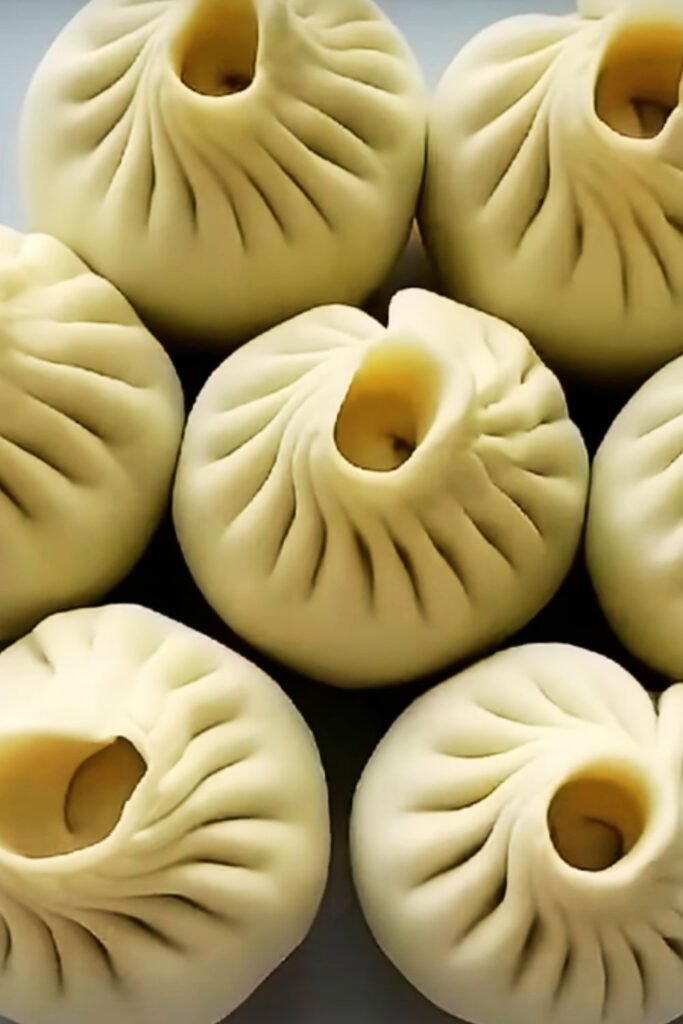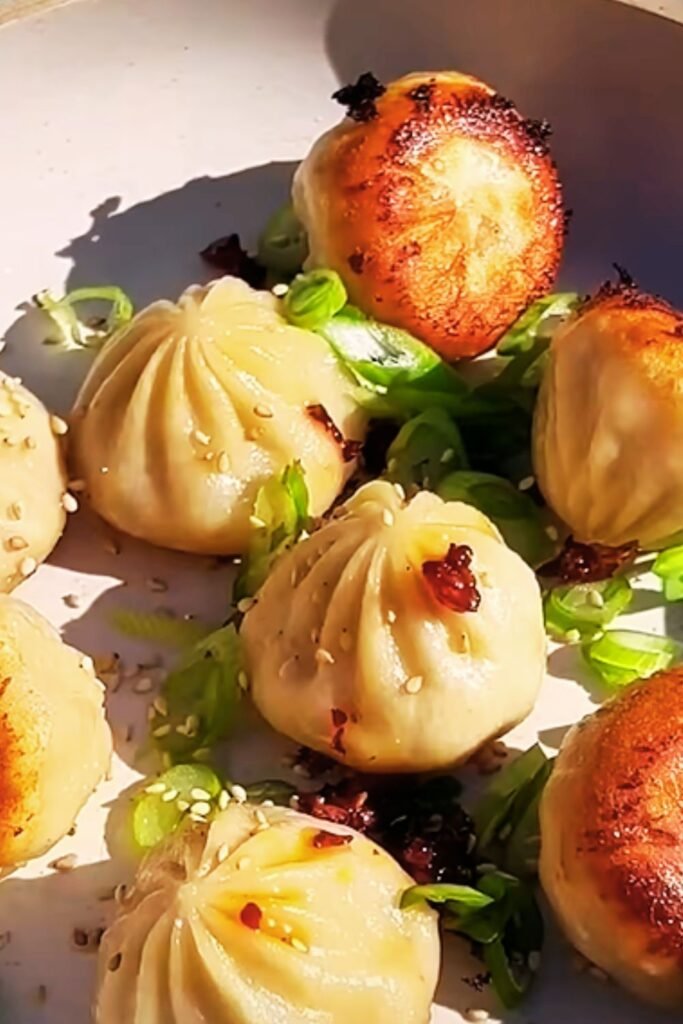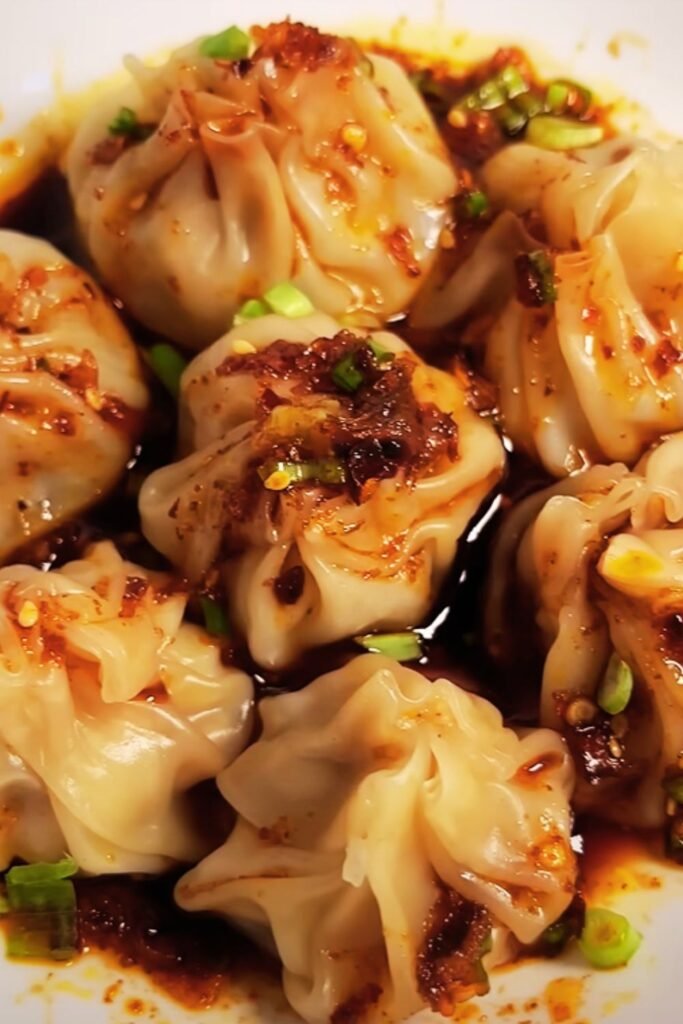Have you ever bitten into a perfect soup dumpling and felt that magical moment when the savory broth bursts in your mouth? I still remember my first experience with xiao long bao in Shanghai—it was a culinary revelation that changed my understanding of what a dumpling could be. Today, I’m sharing my carefully perfected recipe for making these incredible soup-filled treasures at home.
While soup dumplings might seem intimidating to make, I’ve broken down the process into manageable steps that any home cook can follow. Yes, it takes time and patience, but the result is absolutely worth it. There’s something deeply satisfying about creating these little bundles of joy from scratch and watching your friends’ and family’s faces light up when they taste them.
What Are Soup Dumplings?
Xiao long bao (小笼包), literally “little basket buns,” are a type of Chinese steamed dumpling that originated in Shanghai. What makes them unique is the soup inside—yes, actual liquid soup encased within the dumpling wrapper! This seemingly magical feat is accomplished by adding cooled, gelatinized broth to the filling, which melts into liquid when steamed.
Traditional xiao long bao contains pork filling, though variations with crab, shrimp, or vegetable fillings have become popular. The wrappers are delicate, with at least 18 pleats per dumpling—a mark of a skilled dumpling maker.
The Essential Components
Making soup dumplings requires three main elements:
The Gelatinized Broth (Aspic) : The secret to the “soup” in soup dumplings. This rich broth is cooked with collagen-rich ingredients like pork skin and feet, then chilled until it solidifies into a gelatin.
The Filling : Usually a mixture of ground pork, ginger, green onions, and seasonings combined with diced aspic.
The Wrapper : A simple dough made from flour, water, and sometimes a little oil, rolled extremely thin.
Making the Aspic (Soup Gelatin)

The most crucial component of soup dumplings is the aspic—the solidified broth that melts into soup during steaming. This requires bones and connective tissue with natural gelatin.
Ingredients for Aspic:
| Ingredient | Amount | Notes |
|---|---|---|
| Pork neck bones | 1 lb (450g) | Ask your butcher for bones with meat attached |
| Chicken feet | 1/2 lb (225g) | Adds rich collagen |
| Pork skin | 4 oz (115g) | Optional but recommended for extra gelatin |
| Cold water | 8 cups (2 liters) | Enough to cover ingredients |
| Ginger | 3-inch piece, sliced | No need to peel |
| Green onions | 4, white parts only | Save green parts for filling |
| Shaoxing wine | 2 tablespoons | Chinese rice wine |
| White pepper | 1/2 teaspoon | Provides subtle heat |
| Salt | 1 teaspoon | Adjust to taste |
Instructions:
- Clean the bones and chicken feet thoroughly. For the pork skin, blanch it in boiling water for 2 minutes, then scrape off any remaining fat with a knife.
- Place all ingredients in a large pot and cover with cold water.
- Bring to a boil, then immediately reduce to a very low simmer.
- Skim off any foam or impurities that rise to the surface.
- Simmer gently for 3-4 hours, occasionally skimming. The liquid should reduce by about one-third.
- Strain the broth through a fine-mesh sieve, pressing on solids to extract all liquid.
- Let cool slightly, then refrigerate overnight or for at least 8 hours until completely set.
- Once solidified, dice the aspic into small 1/4-inch cubes and keep refrigerated until ready to use.
Time-Saving Alternative:
If you’re short on time, you can use unseasoned gelatin powder:
| Ingredient | Amount | Notes |
|---|---|---|
| Good quality chicken or pork broth | 2 cups (480ml) | Store-bought is acceptable |
| Unflavored gelatin powder | 1 tablespoon (15g) | About 3 standard packets |
| Soy sauce | 1 tablespoon | For flavor |
| Shaoxing wine | 1 tablespoon | For authentic taste |
| Ginger | 1-inch piece, grated | For aroma |
| White pepper | 1/4 teaspoon | For subtle heat |
- Heat half the broth with all seasonings and bring to a simmer for 10 minutes.
- Sprinkle gelatin over the remaining cold broth and let stand for 5 minutes.
- Mix the hot seasoned broth with the gelatin mixture, stirring until completely dissolved.
- Pour into a shallow container and refrigerate until firm, about 4 hours.
- Dice into small cubes when ready to use.
The Perfect Filling
The filling for soup dumplings should be flavorful but not overpowering, allowing the soup’s richness to shine through.
Ingredients for Filling:
| Ingredient | Amount | Notes |
|---|---|---|
| Ground pork (not too lean) | 1 lb (450g) | 70-80% lean is ideal |
| Diced aspic (from recipe above) | 1 cup | Keep refrigerated until the last moment |
| Green onions, finely minced | 3 tablespoons | White and light green parts |
| Ginger, finely grated | 1 tablespoon | Fresh is essential |
| Shaoxing wine | 1 tablespoon | Chinese cooking wine |
| Light soy sauce | 1 tablespoon | Not dark soy sauce |
| Sesame oil | 1 teaspoon | Adds nutty aroma |
| Sugar | 1 teaspoon | Balances flavors |
| White pepper | 1/4 teaspoon | For subtle heat |
| Salt | 1/2 teaspoon | Adjust to taste |
Instructions:
- In a large bowl, add ground pork and all seasonings except the aspic.
- Stir in one direction (clockwise or counterclockwise) for about 5 minutes until the mixture becomes sticky and paste-like. This develops the protein structure that creates the bouncy texture.
- Fold in the diced aspic gently but quickly, being careful not to let it melt. Work in batches if needed, keeping unused aspic refrigerated.
- Cover and refrigerate the filling for 30 minutes before assembling dumplings.
The Dumpling Wrapper
Soup dumpling wrappers need to be thin yet strong enough to hold the soup without breaking.
Ingredients for Dough:
| Ingredient | Amount | Notes |
|---|---|---|
| All-purpose flour | 2 1/2 cups (320g) | Plus extra for dusting |
| Boiling water | 1/2 cup (120ml) | For hot water dough portion |
| Cold water | 1/3 cup (80ml) | For cold water dough portion |
| Vegetable oil | 1 teaspoon | Helps prevent sticking |
Instructions:
I use a special “hot water dough” technique that creates the perfect texture:
- Divide the flour into two bowls: 1 1/2 cups in one bowl and 1 cup in another.
- Pour boiling water over the smaller portion (1 cup) while stirring rapidly with chopsticks or a fork until it forms small clumps.
- Add cold water to the larger portion (1 1/2 cups) and mix until it forms a shaggy dough.
- Combine both mixtures and the oil, then knead for 8-10 minutes until smooth and elastic. The dough should be fairly firm but pliable.
- Cover with a damp cloth and let rest for 30 minutes.
- After resting, knead briefly and roll into a long cylinder about 1 1/2 inches in diameter.
- Cut into 1-inch pieces (you should get about 24-28 pieces).
- Press each piece into a disc with your palm, then use a small rolling pin to roll into circles about 3 1/2 to 4 inches in diameter, keeping the center slightly thicker than the edges.
Rolling Technique:
The traditional method for rolling wrappers is to rotate the dough disc with your left hand while rolling with a small dowel-like rolling pin in your right hand (reverse if left-handed):
- Hold the edge of the dough with your fingertips.
- Roll from the edge toward the center, rotating slightly after each roll.
- The wrapper should be very thin around the edges (almost translucent) and slightly thicker in the center.
Keep the prepared wrappers covered with a damp cloth to prevent drying out.
Assembling the Dumplings

This is where patience and technique come into play. Take your time with the first few until you get comfortable with the process.
Instructions:
- Hold a wrapper in your non-dominant hand.
- Place about 1 tablespoon of filling (including some aspic cubes) in the center.
- Start pleating by pinching a small section of the edge between your thumb and index finger.
- Continue pleating around the circumference, making sure each pleat overlaps the previous one slightly. Traditional xiao long bao have 18+ pleats.
- As you work your way around, gradually squeeze out any air and seal the top by twisting and pinching firmly.
- Place finished dumplings on a parchment-lined tray dusted with flour.
Pleating Tips:
- Keep the center of the wrapper higher than the edges as you pleat, creating a “purse” shape.
- Make sure there are no holes or tears in the wrapper.
- If the edge of the wrapper dries out and becomes difficult to seal, dab with a tiny bit of water.
- The finished dumpling should look like a little purse with a sealed topknot.
Cooking the Dumplings
Soup dumplings are traditionally steamed in bamboo steamers, which absorb excess moisture and allow for gentle, even cooking.
Steaming Setup:
| Item | Description | Purpose |
|---|---|---|
| Bamboo steamer | 10-inch recommended | Traditional and functional |
| Parchment paper | Cut into 3-inch squares | Prevents sticking |
| Cabbage leaves | Optional alternative to parchment | Natural non-stick surface |
| Wok or large pot | Wide enough to hold steamer | Creates steam bath |
Instructions:
- Line each layer of your bamboo steamer with parchment paper squares or cabbage leaves.
- Place dumplings on the liners, leaving at least 1 inch between each (they will expand during cooking).
- Fill a wok or large pot with about 2 inches of water and bring to a boil.
- Place the loaded steamer over the boiling water, making sure the water doesn’t touch the bottom of the steamer.
- Cover and steam for exactly 10 minutes. Do not open the lid during steaming.
- Remove from heat but don’t uncover immediately—let rest for 1 minute to prevent the dumplings from collapsing due to sudden temperature change.
The Dipping Sauce
A traditional dipping sauce balances the rich dumplings with acidity and spice.
Classic Black Vinegar Dipping Sauce:
| Ingredient | Amount | Notes |
|---|---|---|
| Chinkiang black vinegar | 1/4 cup | The traditional choice |
| Fresh ginger, julienned | 1 tablespoon | Thin matchstick cuts |
| Light soy sauce | 1 teaspoon | Optional, for extra flavor |
| Sugar | 1/2 teaspoon | Balances acidity |
| Chili oil | Few drops | Optional, for heat |
Mix all ingredients and let sit for at least 15 minutes before serving.
How to Eat Soup Dumplings

Eating soup dumplings is an art in itself! Here’s the technique I recommend to my guests:
- Carefully pick up a dumpling by its topknot using chopsticks and place it on your spoon.
- Take a small bite from the side of the dumpling to create an opening.
- Carefully sip the soup through this opening.
- Add a little dipping sauce if desired.
- Eat the rest of the dumpling in one or two bites.
Make-Ahead and Storage Tips
Soup dumplings are best enjoyed fresh, but you can prepare components ahead of time:
Aspic:
- Can be made up to 3 days in advance and kept refrigerated.
- For longer storage, cut into cubes and freeze for up to 1 month.
Filling:
- Can be prepared up to 24 hours in advance (without aspic).
- Add aspic just before forming dumplings.
Assembled Dumplings:
- Can be frozen before cooking: Arrange on a flour-dusted tray, freeze until solid, then transfer to airtight containers.
- Cook frozen dumplings directly (do not thaw), but add 2 extra minutes to steaming time.
Serving Suggestions
Traditionally, xiao long bao are served as part of a larger dim sum spread. Here are some complementary dishes:
- Scallion pancakes
- Hot and sour soup
- Chinese broccoli with oyster sauce
- Steamed rice
- Jasmine or oolong tea
Troubleshooting Common Issues
| Problem | Possible Cause | Solution |
|---|---|---|
| Dumplings leak during steaming | Wrapper too thin or holes in wrapper | Ensure wrapper is even thickness; check for tears before steaming |
| Not enough soup inside | Aspic melted during mixing | Work quickly; keep aspic very cold; refrigerate filling between batches |
| Dough too sticky to work with | Too much water in dough | Add flour gradually until workable; dust work surface generously |
| Dough too stiff | Not enough water or over-kneaded | Add a few drops of water; let rest longer before rolling |
| Dumplings stick to steamer | Insufficient lining | Use parchment paper or cabbage leaves; don’t overcrowd steamer |
| Filling too dense after cooking | Over-mixed filling | Stir filling just until combined; don’t compact when filling dumplings |
Variations to Try
Once you’ve mastered the basic recipe, experiment with these variations:
Crab and Pork Soup Dumplings:
Add 4 oz (115g) of fresh crab meat and reduce pork to 12 oz (340g). Include a touch of shaoxing wine and a bit more ginger.
Chicken and Mushroom:
Replace pork with ground chicken thigh meat. Add 1/4 cup finely diced rehydrated shiitake mushrooms.
Vegetarian Option:
Use vegetable stock with extra agar-agar for the aspic. Fill with a mixture of finely chopped mushrooms, tofu, cabbage, and carrots seasoned with five-spice powder.
Spicy Version:
Add 1-2 teaspoons of chili oil and a pinch of Sichuan peppercorns to the standard pork filling.
Questions and Answers
What’s the most important tip for successful soup dumplings? Keep everything cold! The aspic must remain solid until the dumplings hit the steamer. Work in small batches, keeping unused aspic and filling refrigerated.
Can I use store-bought dumpling wrappers? Regular dumpling or wonton wrappers are typically too thin and will burst. If you must use store-bought, look for thicker Shanghai-style dumpling wrappers and use two layers.
My dumplings deflated as soon as I took them out of the steamer. What went wrong? This often happens with sudden temperature changes. After steaming, let the dumplings rest covered for 1-2 minutes before serving.
Is there a shortcut for making the aspic? Yes! As mentioned in the recipe, you can use good quality broth with unflavored gelatin powder. While not quite the same as traditional bone broth aspic, it produces acceptable results for home cooking.
How can I tell if I’ve pleated my dumplings correctly? A properly pleated soup dumpling stands upright with a flat bottom and should have at least 18 pleats. The top should be completely sealed with no openings.
Can I steam these in something other than a bamboo steamer? Yes, any steamer will work, but bamboo absorbs excess moisture and prevents condensation from dripping onto the dumplings. If using a metal steamer, cover the lid with a clean kitchen towel to catch condensation.
How do I know when they’re done cooking? Soup dumplings need exactly 10 minutes of steaming (12 if frozen). The wrappers will become slightly translucent, and the dumplings will feel firm but slightly springy when gently touched.
My filling is too wet and leaking through the wrappers. How can I fix this? Return the filling to the refrigerator to firm up. If still too wet, you can add 1-2 tablespoons of cornstarch to absorb excess moisture.
While making soup dumplings at home requires patience and practice, the result is incredibly rewarding. There’s nothing quite like setting a steaming basket of homemade xiao long bao on the table and watching your guests’ eyes widen with delight. The first time you successfully bite into one of your creations and taste that burst of rich, savory soup, you’ll understand why these dumplings have captivated food lovers around the world.
Remember that even professional chefs have to practice this technique, so don’t be discouraged if your first batch isn’t perfect. Each time you make them, your pleating will improve, and soon you’ll be creating restaurant-quality soup dumplings in your own kitchen. Happy steaming!